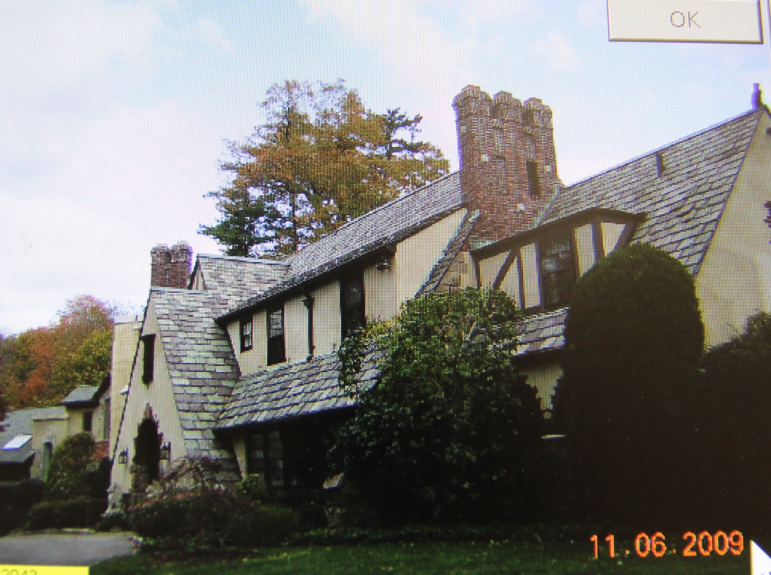The decision was a long time in the making.
Multiple hours-long public hearings about the fate of property at 21 Calhoun Drive drew testimony from property owners in the private Calhoun Drive Association, which that features numerous historic homes with mature landscaping.
The applicant was Annette Perry, who sought a Historic Overlay (HO), site plan and special permit for a new home that would be secondary to the primary dwelling at 21 Calhoun Drive, named “Park Hill,” a historic Tudor style home constructed in 1923.
Attorney John Tesei said his clients had initially intended to build a spec house on an adjacent lot on Turner Drive, and raze 21 Calhoun and build a new house there.
Instead he said they learned about the HO possibility and sought to preserve the historic house’s facade in perpetuity in exchange for permission to build a “subordinate dwelling” or “carriage house” in the front yard, which slopes down to the street.
Repeatedly neighbors balked, saying the proposed “carriage house” was actually a full size house and would be out of character for the neighborhood. The applicant made several modifications, including reducing the size of the proposed house.
In the end there was a split vote on whether the application was worthy of a Historic Overlay.
On P&Z a vote of 2 to 3 is considered “a split vote.” It would have taken a vote of 4 in favor to carry, and therefore is a de facto denial.
Two members, chair Margarita Alban and David Hardman felt the application was not worthy of the Historic Overlay and voted against the application.
Three members voted in favor: Nick Macri, Andy Fox and Peter Levy.
Mr. Fox said he was “in between” on the merits of the application, but noted that the Historic District Commission had acknowledged the historical significance of the structure.
“We heard loud and clear the neighborhood was not in favor of this application, butt I think personally it’s hard when we see all these classic houses get torn down,” Fox said.
Mr. Macri agreed that the house was historic in nature.
“I found that actually the proposed house was quite large but has been reduced down to an appropriate size and there are a lot of estate buildings with accessory carriage houses or outbuildings,” Macri said.
The developers purchased the property on March 19, 2019 for $3,100,000.
Commissioner Peter Levy called his decision “a close call.”
“I think the size of this development bothers me,” he said, adding, “But I think it’s a respectful design and they’ve done some good things to fit it into the landscape. There have been astute comments by neighbors about why this does not fit into the streetscape and that the proximity of the house to the main house is not in keeping with the character of the neighborhood, but developing this property this way has more benefits than detractions.”
Commissioner Dave Hardman said he appreciated the historic character of the neighborhood, but noted the house was not even visible from Calhoun Drive.
“And I do question whether the original owner was more historic than the home,” he said.
He said the POCD preservation of neighborhood character and sense of place is an existential land use considerations for the Town.
“This is a charming neighborhood,” Hardman said. “It does substantially alter the neighborhood.”
He noted the HO states, “A new additional shall not destroy spatial relationships.”
“Particularly on this lot,” Hardman said. “Everyone has talked so far about the pros and cons of the property. I just don’t believe putting an additional structure this size, this close to the road – and there’s no choice because of the topography – does anything but destroy the spatial relationships.”
“The neighbors have been articulate and insistent,” Hardman added. “I really respect that.”

Also, he asked, “What defines neighborhood character? It’s curved streets and houses set back from the road and extensive landscaping with trees. Despite all the applicant presented us, it’s not enough.”
Ms Alban said she had driven around the neighborhood as well. She noted how Historic Overlay, Section 6-109 addressed spatial relationships that encompass an entire property – not just the structures on it.
“This neighborhood and streets are characterized by gracious, old lovely homes, “she said. “But they are set back far from the street with a high, often a very large, expansive lawn going toward the street, or extensive landscaping.”
She acknowledged that there are some accessory structures close to the street, as well as newer homes built with significantly lower setbacks. But, she said the overall historic character of the neighborhood is one of extensive setbacks, open spaces and landscaped areas.
“I believe the proposal does not meet the historic character of the neighborhood. At the same time, not granting the HO, would mean that there is no protection (for the historic house),” Alban said. “But we’ve raised the topic in the community and the answer has been that the character of the neighborhood as it’s laid out is more important.”

See also: